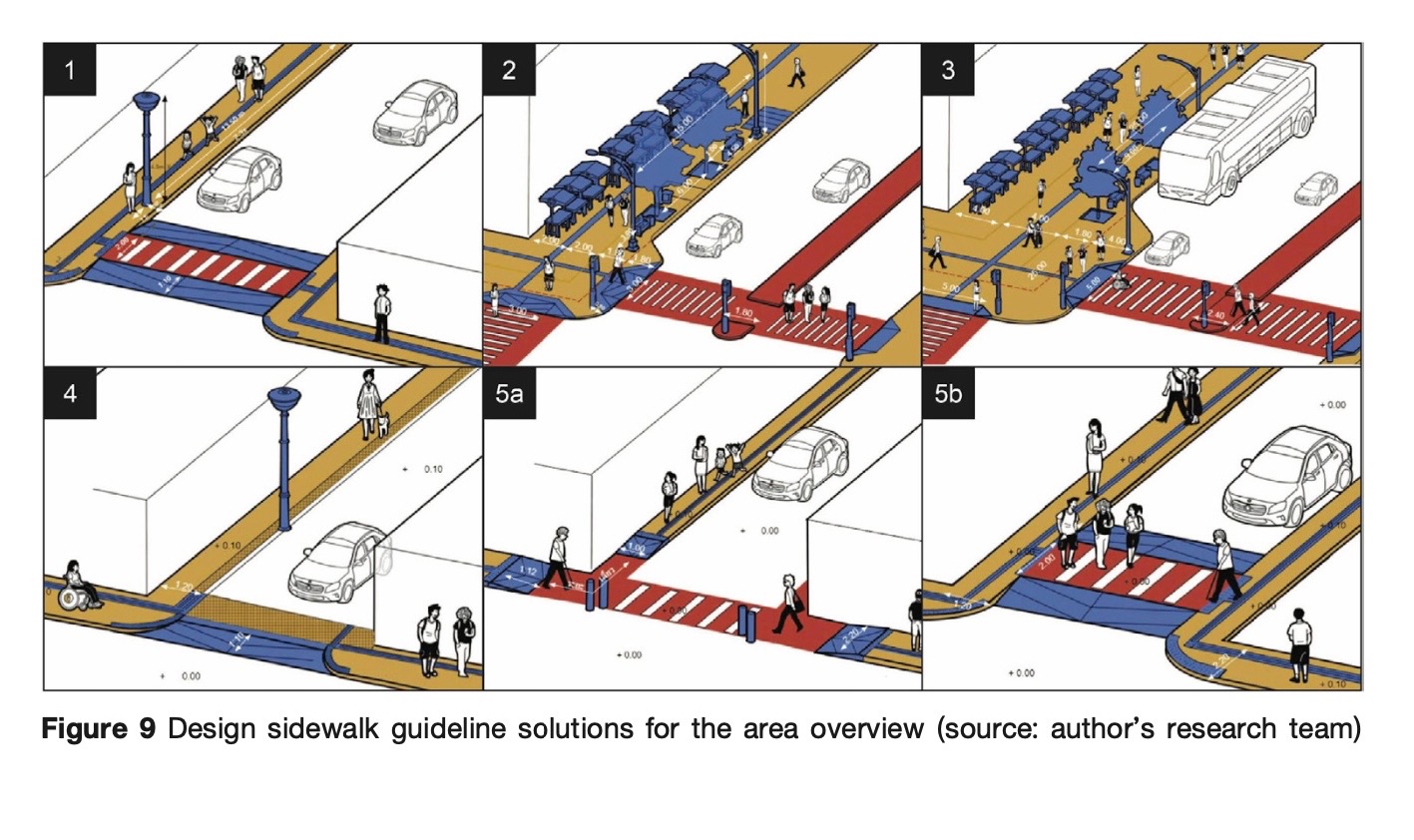The Walking Bangkapi: Inclusive Pedestrian Network’s Integrated Design and Implementation Study on Bangkok’s Emerging Transportation District
Main Article Content
Abstract
With a city growing in size, capacity, density, and intensity, walkability in the Bangkapi district (Bangkok, Thailand) represents a challenge to produce more inclusive transportation through mobility planning that suits the multimodal transportation system (skywalk, MRT lines, water transportation) and the walking experience of the pedestrian. Drawing from Bangkok’s Transit-Oriented Development (TOD) strategic plan, the challenge lies in the balancing point of efficiently and effectively elevating walkability while keeping the local urban identity. This study investigates the notion of walkability as both a ground-up participatory design process and within the overall mobility planning framework by reviewing both Thai and international sidewalk standards and through interviews with stakeholders. We conclude by producing an experimental design guide and policy recommendations on how area-specific sidewalks have the potential in shaping more feasible and equitable mobility planning from the ground up.
Downloads
Article Details

This work is licensed under a Creative Commons Attribution-NonCommercial-NoDerivatives 4.0 International License.
All material is licensed under the terms of the Creative Commons Attribution 4.0 International (CC-BY-NC-ND 4.0) License, unless otherwise stated. As such, authors are free to share, copy, and redistribute the material in any medium or format. The authors must give appropriate credit, provide a link to the license, and indicate if changes were made. The authors may do so in any reasonable manner, but not in any way that suggests the licensor endorses you or your use. The authors may not use the material for commercial purposes. If the authors remix, transform, or build upon the material, they may not distribute the modified material, unless permission is obtained from JARS. Final, accepted versions of the paper may be posted on third party repositories, provided appropriate acknowledgement to the original source is clearly noted.
References
Boston Transportation Department. (2013). Boston complete streets design guidelines. Retrieved May 4,2021, from https://www.boston.gov/sites/default/files/file/2019/12/BCS_Guidelines.pdf
City of Johannesburg. (2013). City of Johannesburg complete streets design guideline. Retrieved May 4,2021,from https://www.joburg.org.za/departments_/Documents/transport/department%20project/Complete%20Streets%20Design%20Guideline%20Manual.pdf
De Sousa Santos, B. (2016). Epistemologies of the South: Justice against epistemicide. Routledge. Department of Local Administration, Ministry of Interior. (2011). Māttrathān Faifā Sāthārana [Public lighting standard]. Retrieved May 4, 2021, from http://www.dla.go.th/work/e_book/eb1/stan3.htm
Department of Local Administration, Ministry of Interior. (2011). Māttrathān Thanon Thāng dœ ̄ n læ Thāngthao [Standards of Road, Sidewalk, and Pedestrian]. Retrieved May 4, 2021, from http://www.dla.go.th/work/e_book/eb1/stan1.htm
Dovey, K., & Pafka, E. (2020). What is walkability? The urban DMA. Urban Studies, 57(1), 93–108. https://doi.org/10.1177/0042098018819727
Dovey, K., Van Oostrum, M., Chatterjee, I., & Shafique, T. (2020). Towards a morphogenesis of informalsettlements. Habitat International, 104, 102240. https://doi.org/10.1016/j.habitatint.2020.102240
Gehl, J. (2011). Life between buildings: using public space. Island Press.
Global Designing Cities Initiative & National Association of City Transportation Officials (NACTO-GDCI). (2016).Global street design guide. Island Press.
Harris, C. W., & Dines, N. T. (1998). Time-saver standards for landscape architecture. McGraw-Hill
Institute of Public Works Engineering Australasia, Queensland (IPWEAQ), (2020). Street design manual - walkable neighborhood. Retrieved May 4,2021, from https://dsdmipprd.blob.core.windows.net/general/street-design-manual.pdf.
Jacquier, C. (2005). On relationships between integrated policies for sustainable urban development and urban governance. Tijdschrift Voor Economische En Sociale Geografie, 96(4), 363–376. https://doi.org/10.1111/j.1467-9663.2005.00469.x
Land Transport Authority & Urban Redevelopment Authority (LTA-URA). (2018). Walking and cycling design guide. Retrieved May 4,2021, from https://www.ura.gov.sg/Corporate/Guidelines/-/media/BD725DB201DB496A93569C8072DD9FD0.ashx.
Legislative Council. (2004). Public consultation report for pedestrian plan for Causeway Bay area. Retrieved February 11, 2024, from https://www.legco.gov.hk/yr04-05/english/panels/plw/papers/plwcb1-1376-e.pdf
Ministry of Transportation. (2016). Criteria and and infrastructure standard, and transportation facilities for disabled, children, and elders. Retrieved April 22, 2021, from http://otptransportforall.org/index.php/2-uncategorised/14-manual
Road Safety Policy Foundation. (2018). Khūmư̄ kānʻō̜kbǣp Thāngkhām Thanon thī Plō̜tphai [Handbook of safety crosswalk]. Retrieved May 11, 2021, from http://roadsafetythai.org/edoc/doc_20181120163620.pdf
Standard Department, Engineering and Planning Department. (2006). Kēn læ Māttrathān Phangmư̄ang rūam Phō̜.Sō̜. 2549 [Criteria and Standard for Comprehensive Planning B.E.2549]. Retrieved May 4, 2021,from http://subsites.dpt.go.th/edocument/images/pdf/sd_urban/std_plan.pdf
Songpetchmongkol, W. (2022). Density, in relationship to the network of street vendors: A look at Bangkok’s block density & their representation of public realms. Academia Letters, Article 4883. https://doi.org/10.20935/al4883
Speck, J. (2012). Walkable city: How downtown can save America, one step at a time. Farrar, Straus and Giroux.
Toronto City Council. (2017). Toronto complete streets guidelines edition 1. Volume 1. 2017. Retrieved May 4,2021, from https://www.toronto.ca/services-payments/streets-parking-transportation/enhancing-our-streets-and-public-realm/complete-streets/complete-streets-guidelines
Thorpe, E. (2019). Making integrated urban development more manageable. URBACT. Retrieved May 4,2021,from https://urbact.eu/making-integrated-urban-development-manageable


